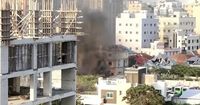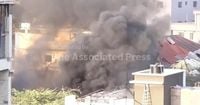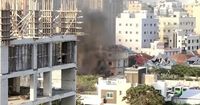Explosions and heavy gunfire shattered the quiet of central Mogadishu on Saturday, October 4, 2025, as Somalia’s capital was rocked by a brazen assault targeting the Godka Jilacow prison—an institution that doubles as the headquarters for the regional intelligence unit and sits just steps away from the presidential palace. The al-Qaida-linked al-Shabab militant group swiftly claimed responsibility for the attack, which unfolded mere hours after the federal government dismantled roadblocks that had, for years, choked the city’s arteries in the name of security.
For many Mogadishu residents, the day began with a sense of newfound freedom. The government’s decision to lift the long-standing barriers was intended to restore the city’s flow, allowing commerce and daily life to return to a more normal rhythm. But that optimism was short-lived. As the sun climbed higher, the sounds of explosions and automatic gunfire echoed through Bondhere district, sending people scrambling for cover and reigniting old fears.
According to The Associated Press, residents in Bondhere reported seeing thick smoke billowing from the prison compound. One local, Hibo Mohamed, captured the city’s mood in a phone interview: “We are truly scared. The city had been calm for months, but now everyone feels anxious once more.” Her words reflected a collective anxiety that had lain dormant during months of relative peace but resurfaced with a vengeance on this violent morning.
Details of the assault emerged piecemeal as the situation unfolded. Somalia’s state media reported that the attackers used a vehicle disguised to resemble those of the intelligence unit’s security forces, allowing them to get close to the heavily fortified prison. The militants’ goal, according to their own statements, was to free prisoners held inside. Al-Shabab later boasted that it had succeeded in releasing some detainees, though the government did not immediately confirm or deny this claim. Attempts by journalists to reach government officials for comment went unanswered throughout the day.
The Godka Jilacow prison is no stranger to violence. In 2014, the same facility was the site of a deadly assault when al-Shabab fighters detonated a suicide car bomb at the gate and stormed the compound in a bid to liberate prisoners. That attack left at least a dozen people dead and underscored the prison’s symbolic and strategic importance in the ongoing conflict between the Somali state and the militant group.
Saturday’s attack followed a similar pattern, but this time, government soldiers responded quickly. According to state media, security forces repelled the attackers and killed several militants in the ensuing firefight. Roads leading to the scene were cordoned off, and ambulances rushed in to tend to the wounded. Despite the chaos, the authorities did not immediately release information about civilian or military casualties, leaving families across Mogadishu desperate for news.
The timing of the assault has sparked debate among residents and analysts alike. The roadblocks—though unpopular for their impact on daily life and commerce—were widely seen as a necessary evil, a bulwark against precisely this kind of attack. Their removal, intended to signal a new era of confidence in the city’s security, now appears tragically premature to some. Others, however, argue that the barriers had become permanent fixtures that stifled economic activity and movement, pointing to the need for more sustainable, community-based security solutions.
In the hours after the attack, security forces established a tight perimeter around the prison and presidential palace, effectively sealing off the heart of the city. Ambulances and emergency personnel worked frantically, but the number of casualties remained unclear as evening fell. For residents, the uncertainty was almost as distressing as the violence itself.
It’s a bitter turn of events for Mogadishu, which had enjoyed a period of relative calm in recent months. Government forces, bolstered by local militias and African Union troops, had managed to push al-Shabab fighters out of several strongholds in central and southern Somalia. The capital, long synonymous with instability, had begun to exhale—businesses reopened, markets bustled, and families ventured out after dark. Saturday’s events, however, served as a stark reminder of the city’s lingering vulnerabilities.
Al-Shabab’s tactics have evolved over the years, but their core strategy remains unchanged: high-profile attacks designed to undermine public confidence in the government and disrupt any sense of normalcy. The group’s ability to infiltrate one of the city’s most secure areas, using a vehicle disguised as an intelligence unit car, highlights both their resourcefulness and the ongoing challenges facing Somali security forces.
For many Somalis, the attack is deeply personal. The Godka Jilacow prison, with its grim reputation and history of violence, looms large in the national psyche. Its repeated targeting by militants is not just a blow to the state but a psychological assault on the people’s sense of security. The fact that this latest attack came so soon after the lifting of roadblocks only adds to the sense of vulnerability.
As the dust settled, some residents questioned whether the government had moved too quickly in its push to reopen the city. “We wanted to believe things were getting better,” said another Bondhere local, who asked not to be named. “But maybe we let our guard down too soon.” Their sentiments echo a broader dilemma facing Somali leaders: how to balance the demands of security with the need for economic and social recovery.
Government officials, for their part, have remained largely silent in the immediate aftermath. With phone lines and messaging services flooded, many families waited anxiously for updates. Meanwhile, security experts warned that al-Shabab’s claim of releasing prisoners, if true, could have implications for future attacks, given the group’s history of recruiting and redeploying freed fighters.
The international community, which has invested heavily in Somalia’s stabilization, will be watching closely. The African Union and other partners have long urged Somali authorities to strengthen institutional capacity while also addressing the root causes of militancy—poverty, unemployment, and political marginalization. Saturday’s attack is likely to renew calls for both immediate action and long-term reform.
For now, Mogadishu’s residents are left to pick up the pieces. The city’s fragile calm has been shattered, and the path forward is uncertain. As night fell over the capital, the once-bustling streets were eerily quiet, haunted by the memory of gunfire and the knowledge that, for all its progress, Somalia’s struggle with violent extremism is far from over.






